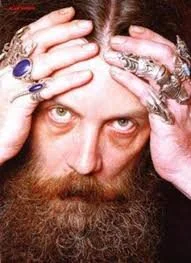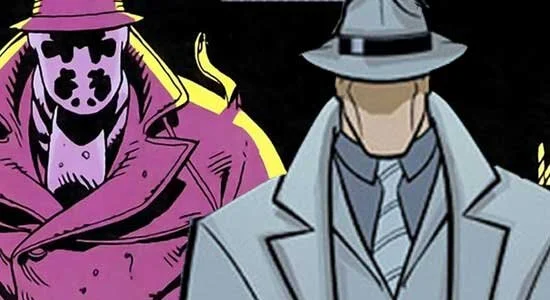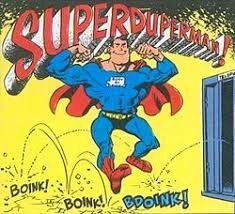Who Owns (the) Watchmen?
One of the most complicated graphic novels every to gain broad attention and acclaim, Watchmen has an equally complicated backstory and afterlife, raising questions of authorship, copyright, originality, and fairness. Not to mention the ties to the comics industry's long and ugly history of screwing over its most accomplished creators. A story that starts with a big American corporation (DC Comics/Time Warner) wooing an idiosyncratic British creator to do work for hire (Alan Moore on Swamp Thing) quickly devolved into mutual recriminations and over thirty years of bad blood.
DON’T MESS WITH ALAN MOORE
The genesis of Watchmen is both corporate and creative. DC Comics had recently acquired the rights to a stable of characters from the defunct Charlton Comics, and now had to decide what to do with them. This was not an unprecedented situation; after Quality Comics closed its doors in 1956, DC purchased their trademarks and characters, initially consigning them an alternate earth rather than that of Superman and Batman, before the twelve-issue series Crisis on Infinite Earths integrated them into a revamped DC Universe a few months before Watchmen’s premiere. Crisis had featured some of the Charlton heroes in supporting roles (on their own alternate earth, mostly as extras), but nothing in that series foreclosed any possibilities for their future use.
After briefly considering revamping a group of heroes from yet another failed comics line, Moore submitted a pitch to DC that would use all the major Charlton characters to tell a single, extended story. The editors liked his idea, but it didn’t conform to mainstream comic's customary strategy for exploiting their intellectual property: publishing stories about their characters for as long as they would sell. As anyone who has read Watchmen (or the pervious posts) knows, the ending, despite some elements of ambiguity, does not leave the characters in a good position for further storytelling. Watchmen was sequel-proof (or almost sequel proof, as recent events sadly show). So Moore created his own characters to take the place of the Charlton heroes, giving him the latitude to kill, maim, or otherwise dispatch them with impunity.
CAPTAIN ATOM, OR, WHY DR. MANHATTAN PREFERS TO BE NAKED
A scorecard, for those keeping track: Captain Atom became Dr. Manhattan; Peter Cannon, Thunderbolt transformed into Ozymandius, Nightshade was now Silk Spectre, The Question turned into Rorschach, Blue Beetle morphed into Nite-Owl, and the Peacemaker was retooled to become the Comedian. Some of the original heroes have gone on to fairly successful careers in DC (Captain Atom, numerous iterations of the Blue Beetle), while Peter Cannon, after a brief, unremarkable revival by DC in the 1980s and an equally forgettable series by Dynamite in 2012-2013, now headlines another Dynamite series whose aesthetic innovations have more to do with reacting to Watchmen than with any previous incarnations of the character (more about this series in an upcoming post).
PREPARING A FACE TO MEET THE FACES THAT YOU MEET
For most people who live actual lives, the names of these various heroes are not particularly significant. But the sheer fact of these multiple iterations of the characters (not to mention Archie Comics' Mighty Crusaders, whom Moore originally envisioned as his protagonists) reminds us that we are dealing less with specific characters than with archetypes. And not just any archetypes, but archetypes developed and/or owned by DC Comics. Watchmen is a variation on a now standard set of (mostly) masked men and women: the godlike übermensch (Superman/Dr. Manhattan), the grim detective (Batman/Rorschach), the animal totem (Hawkman/NIte-Owl), and, sadly, The Girl (Black Canary/Silk Spectre). We then throw in a few later innovations to the model, such as the gun-toting tough guy (The Punisher/The Comedian) and yet another variation on Batman (Ozymandias), and we have the main cast of Watchmen.
All of this is a bit of a challenge to conventional notions of authorship and originality. On the one hand, if most superheroes are just the latest iterations of decades-old intellectual property, how much praise can we heap on a writer or artist who develops the nth variation? On the other hand, if it’s so easy to create your own Superman, why even bother working with established characters who belong to someone else? In fact, inventing analogues to famous superheroes has become a common tactic for comics creators who want to own their own work and bypass the restrictions common to corporate comics.
HEY, KIDS! CREATE YOUR OWN SUPERMAN!
Moore has said that he was initially concerned that the story wouldn’t resonate with readers unless they already had some kind of emotional connection with the characters. "Eventually, I realized that if I wrote the substitute characters well enough, so that they seemed familiar in certain ways, certain aspects of them brought back a kind of generic super-hero resonance or familiarity to the reader, then it might work.” Moore and Gibbons achieve precisely this result. Not only are the characters complex and well-realized, but the decades-long history of the world of Watchmen is so well-fleshed out, both in the comics proper and in the accompanying text pieces, that readers could be excused for assuming that they had simply missed several years’ worth of stories before picking up the graphic novel.
Watchmen demonstrates the successful world-building of a great science fiction or fantasy novel, or of a particularly immersive video game: what we see in front of us might be all that has ever been produced, but the effect is such that it feels as if there is a great deal more that we are not seeing. This is all the more appropriate when we factor in the novel’s repeated allusions to fractal geometry and the Mandelbrot Set: Watchmen is the template or formula out of which more of the Watchmen world could have been created, but was not.
So Watchmen is a magnificent achievement of the imagination that never hides its creative debts to generation of previous creators. But it was published by DC Comics, and the mainstream comics industry is not like the world of book publishing: in nearly all cases from the industry’s beginning to the time of Watchmen’s first publication, the creators automatically relinquish ownership of their work to the company that publishes it. By the 1980s, the comics market had already transformed enough so that the contract Moore and Gibbons signed with DC was not a simple assignment of rights: it stipulated that DC owned Watchmen as long as it or its characters were still in print.
HOLD OUT FOR A BETTER CONTRACT, RORSCHACH!
In 1985, this may have sounded like a good deal. Recall the point that I made in my first post: before Watchmen, it was the rare comic that would ever be reprinted, much less in a trade paperback edition available at bookstores. In this, Watchmen was a victim of its own success, helping to transform the industry so that acclaimed or popular comics would be collected and reprinted in virtual perpetuity. In the 30+ years since it premiered, Watchmen has never failed to be one of the top 100 graphic novels sold in the United States every year. It is never going out of print. Which means DC will always own it.
Throw in DC’s decision to sell a Watchmen badge set without sharing the profits, and you can see how a feud begins.
Next: After Watchmen: Originality and Moral Rights
Comments (1)
Anders Davenport 6 months ago · 1 Like
“All of this is a bit of a challenge to conventional notions of authorship and originality. On the one hand, if most superheroes are just the latest iterations of decades-old intellectual property, how much praise can we heap on a writer or artist who develops the nth variation? On the other hand, if it’s so easy to create your own Superman, why even bother working with established characters who belong to someone else? In fact, inventing analogues to famous superheroes has become a common tactic for comics creators who want to own their own work and bypass the restrictions common to corporate comics.”
Very well put. The Squadron Supreme was group of analogues for the Justice League; Aquaman was in some ways DC’s version of Namor, who first appeared two years earlier; and of course the amount of Superman analogues (Captain Marvel, Marvelman, Supreme, Samaritan, etc) that have been created since he first debuted are enormous. Even Batman was essentially a riff on The Shadow.
But ultimately, these characters are not the same thing as the characters that inspired them, and what sets apart the good ones from the bad is what the creators have added to them and/or how they’ve been reinterpreted. (Everyone knows the Squadron Supreme was a riff on the Justice League, but no one would argue that Mark Gruenwald’s 1985 maxiseries was simply a wannabe Justice League story.)
When it comes to the characters in Watchmen, which you point out were originally planned to be the Charlton characters (and the Mighty Crusaders before that), I think that people often point to these origins as a way to take away from what Moore and Gibbons achieved with Watchmen.
Adding to what your fantastic write-up provides, here’s part of another excellent article discussing the Watchmen/Charlton connection:
“Here’s the thing: the Charlton heroes were only ever part of the equation because they were so generic. Superheroes fall into a relatively small set of types – types of powers, types of personality. Yes, Nite Owl is very like Blue Beetle. He’s also very like Batman, Green Arrow, Daredevil and Moon Knight. If Moore had used the Mighty Crusaders, he would have told the same story and the Shield would have been the Peacemaker/Comedian. If he’d been writing a Marvel story, it would have been Captain America. Moore originally picked the Charlton heroes precisely because they didn’t really have much identity of their own, they didn’t come with the same baggage, associations and level of public affection that it would if it was a story about Superman and Batman.”
https://lanceparkin.wordpress.com/2012/02/03/before-charlton/
The reason for Watchmen’s critical and commercial success was due to its storytelling techniques, artistic experimentation, and layered depth. For instance, the readers were responding to Doctor Manhattan’s sense of fourth-dimensional perception and the way in which the story incorporated this concept, not any of the vague similarities the character had with Captain Atom.
How the Charlton characters (and the Mighty Crusaders) factor into the creation of Watchmen is definitely interesting, but I feel that a lot of people mention this factoid simply to take Watchmen down a peg, often in the context of trying to undercut Moore’s anger at DC over having never allowed the rights to revert to him and Gibbons. (BTW I’m not suggesting this is what you’ve done, your article is very insightful and balanced.)




